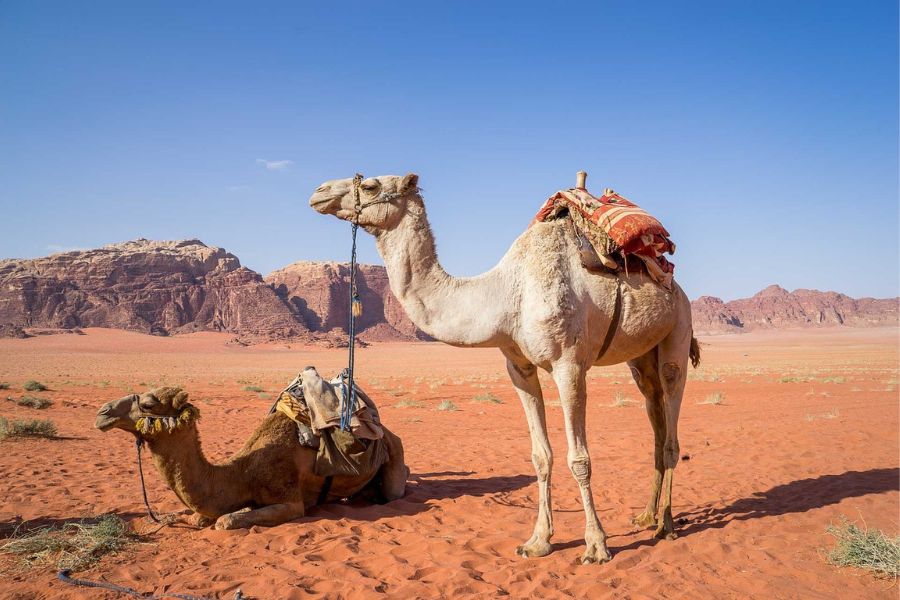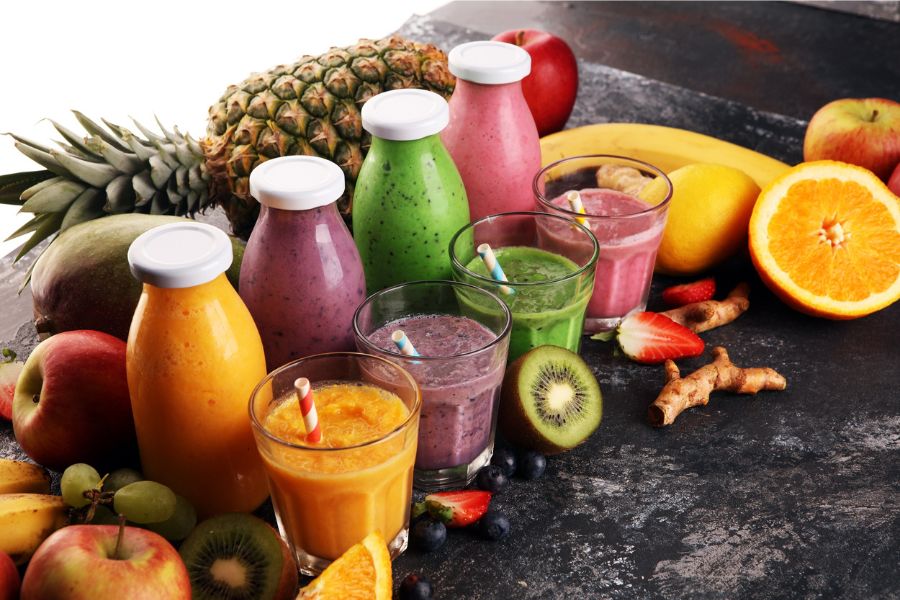‘White Gold’ of the Desert: Unveiling the Riches of Camel Milk

Image source: Pixabay
Often referred to as White Gold of the desert, camel milk is a recognised superfood. It is considered a great source of energy and growth for children, and an excellent healthy option for all. Given that the camels’ diet consists mostly of grass and plants/shrubs in the desert, the the milk has a somewhat saltier flavor. It is consumed in various forms including raw milk, cheese, yoghurt, ice cream, milk powder, camel milk sweets, Ghee, and premium chocolates. It is also used as an ingredient in soaps, face wash, shampoo, skin care products like herbal wax, skin whitening cream and various other products.
The milk of camel is thinner and less viscous than milk of cow, buffalo, sheep, goat, yak etc. Scientists have reported that fresh camel milk can be kept for 8 hr. at 30°C, and when pasteurized, it can be kept for more than 10 days at 4ºC. Fresh milk can be stored at 30ºC for about 20 hrs when lactoperoxidase system is activated.
Camel milk is higher in protein and fat than cow’s milk. It is almost similar to human milk. As compared to cow milk, it has a lower amount of lactose. It also does not contain beta-lacto-globulin, which is the main cause of cow milk allergy. People who are lactose intolerant can safely consume camel milk since its fat globules are smaller than those found in cow’s milk, making it easier to digest.
Being a great source of vital vitamins and minerals, camel milk helps in keeping the body strong and boosts immunity (as it contains the immunoglobulin content). Vitamins like A, B, C, D, E and minerals like calcium, iron, potassium, magnesium, zinc, etc. present in camel milk help in the overall growth and development of the body. It is said to be useful in addressing several health issues and has antioxidant properties that help release oxidative stress, which further help in improving speech and communication problems. Its probiotic nature helps autistic patients maintain their gut health. It keeps their brain and body healthy and reduces hyperactivity, hence it is said that camel milk positively helps in curing autism.
It also has a low sugar and cholesterol level that makes it beneficial for diabetic patients. Moreover, it contains natural Insulin-Like Proteins which helps in maintaining Blood Sugar Levels. It is also used in medicines for the treatment of tuberculosis, asthma, gastrointestinal diseases, jaundice, hepatitis, fever, etc.
Gross composition of milk by type*
| Approximate composition (g/100 g milk) | Camel | Bovine | Human |
| Water | 89.0 (88.7-89.4) | 88.1(87.7-89.2) | 87.8 (87.1-89.3) |
| Total protein | 3.1 (2.4-4.2) | 3.2 (3.1-3.3) | 1.2 (0.9-1.9) |
| Total fat | 3.2 (2.0-6.0) | 3.8 (3.3-5.4) | 3.5 (2.1-4.0) |
| Lactose | 4.3 (3.5-4.9) | 5.1 (4.9-5.6) | 6.4 (6.3-7.0) |
| Ash | 0.8 (0.69-0.9) | 0.72 (0.7-0.8) | 0.2 (0.2-0.3) |
| Total solids | 11.0 (10.6-11.3) | 11.9 (10.8-12.3) | 12.2 (10.7-12.9) |
Source: Botswana University of Agriculture and Natural Resources; *Average and range
Growth trends in the market
Originally, camel milk was cherished by nomadic societies like the Bedouins of Arabia; the Somali, Gabbra, Rendille and Afar in the Horn of Africa; the Tuareg in the Sahara; the Baluch in Pakistan; the Raika and Fakirani Jat in India and many others. It is often called “white gold of the desert”.
That being said, it has entered the market in many countries across the world during the last decade. It significantly contributes to the food security and rural economy in the arid regions of north and east Africa, Central Asia, and the Indian subcontinent. Consumption is rising among the urban populace throughout these regions, as well as in the Middle East.
Africa is the major producer of camel milk in the world, accounting for about 90% of the global fresh whole milk production. Demand has been constantly increasing in Africa where it is being sold and consumed in big cities and towns. Furthermore, certain consumer segments in North America and Europe are also getting more interested in camel milk due to its potential health/medical benefits.
According to a research paper “Consumer Acceptance and Preference for Camel Milk in Selected European and Mediterranean Countries-2022”, annual world production is estimated at 2.9 million tonnes. Somalia is the leading producer with about 1 million tonnes, followed by Kenya, Mali, Ethiopia, Saudi Arabia, Niger, Sudan, the UAE, Mauritania and Chad.
The global market value reached US$ 7.5 billion in 2023, with a 5-year CAGR of 6%. The IMARC Group in its ‘Camel Dairy Market Report’, expects the market to reach US$ 9.9 billion by 2032 at a CAGR of 3% during 2024-2032.
Growing potential of camel milk
While it has been consumed in India since ancient times, the camel milk business is now providing renewed hope to people of arid regions in the country. In Gujarat and some parts of Rajasthan, camel milk is currently gaining commercial status, boosting income for people in the districts of Bikaner, Barmer, Sikar, Ajmer, Jaipur, Churu in Rajasthan and Mandsaur in Madhya Pradesh etc. In some hilly regions of the country it can be of significant utility and a source of revenue as well.
It is interesting to note that a camel produces milk round the year and in larger quantity. It has longer lactation period of about 14-16 months. The production of camel milk in the country is about 23,000 tonnes a year and the potential remains highly underutilised.
The ‘Vision 2030’ document of the National Research Centre on Camel (NRCC Bikaner) proposes programmes and activities in a mission mode to utilize camel and its milk for human benefit. The suggested programs also incorporate activities pertaining to value addition of camel milk and making efforts to highlight its nutraceutical value, with a view to further develop/enhance consumer base.
In an attempt to transform camel into a milch animal and considering the health benefits of camel milk, the Centre is making efforts to promote and popularize it as a health drink through the development of different value added products. Numerous such products have been developed, standardized and evaluated in order to promote them for commercialization. Some of the value added products from camel-milk include:
Ice-cream and Kulfee, Fruit (Sapota) Flavoured Camel Milk, Cheese (Cheddar type), Nuggets, Fruit Flavoured Whey Drink, Sugar Free Lassie, Paneer, Kheer, Chocolate, Gulab Jamun, Barfi, Peda, Sandesh, Spray dried camel milk powder, Lyophilized skim milk powder, Skin Cream, Complete Feed Block/Pellets, etc.
Rising milk consumption, a key growth driver
India leads the world in terms of milk production, accounting for 24.64% share during 2021–22. Milk production during 2021-22 was 221.06 million tonnes, showing an annual growth of 5.29%. Per capita availability of milk was about 444 grams/day in 2021-22.
Increasing purchasing power, shifting dietary and lifestyle preferences, urbanization, and population expansion, have contributed to a spike in milk consumption. Furthermore, factors like growing consumer interest in high protein diets and increasing awareness & availability of dairy products through organized retail chains are also driving growth in consumption of milk, both in rural and urban areas.
In 2022, total domestic consumption of milk in India was over 203 million metric tons, which reached 207 million metric tons in 2023. The market size of freshly packaged dairy food was Rs 968 billion in 2020 and is likely to increase to Rs 1.6 trillion by 2025. In view of this, camels could be used as an additional milk-resource to further increase capacity and support India’s growing population.
In 2016, that the Food Safety and Standards Authority of India (FSSAI) approved it as a food item with specific standards for sale and trade. As per standards, camel milk for sale must contain minimum 3% Fat content and 6.5% Solid Not fat (SNF) content. This was to establish and strengthen the consumer confidence about safety and its nutritional components.
….yet there remain certain challenges
In India, camel milk is commonly consumed by the herders themselves. It is sold in small eateries and tea stalls in Rajasthan and Gujarat. Despite its several health benefits and its potential as a marketable product, the product faces obstacles.
One major challenge is the abundance of milk from other livestock, cows and buffalo are the most common. Camel milk is also slightly salty, which some people may not enjoy/like.
According to Hitesh Rathi of Aadvik Foods, lack of awareness in the country about camel milk has been a key hurdle. His company has a diverse portfolio of camel milk products including chocolates, ghee, cheese and soaps. Also it would not do justice to compare camel milk and considering to bring it at par with other milk. It should be considered more as a nutraceutical. He also stated that it is a healthy choice for lacto-intolerant people. Some of the leading players in this market include Amul, Aadvik Foods, Camel Charisma Pvt ltd., Hye foods, Faith & Patience.
However, compared to cow/buffalo milk, it is more expensive. For instance, Amul Camel Milk 200ml is for Rs.25, while Aadvik RAW Camel Milk Powder 200g comes at Rs. 1,470.00. In comparison, Amul Toned Milk retails for Rs 74 to a litre (around Rs 12 for 200 ml) and Nestle Everyday Milk Powder (400 g) retails for around Rs 250.
Then there is the challenge to create demand, since about 20,000 litres of milk is available every day. There are camel herders who want to sell their milk, but there isn’t enough demand for taking up the excess supply. Since a majority of milk consumers in the country are accustomed to cow and buffalo milk, it might take a little longer for camel milk to become popular as mainstream milk. Government initiatives to promote its beneficial properties will play a pivotal role.
The US and Middle East are some of the big markets for the camel milk products from India. It is easier to export in these countries but for others there are certain issues which may be taken up at government to government level. As Mr. Rathi, points out, there are challenges in exporting to Europe and Canada. These countries have laid down restrictions, not allowing Indian origin dairy products. Then, China could also be one of the biggest markets for India’s camel milk products but is currently inaccessible. He further informed that Japan, South Korea, Southeast Asia and Latin America are among the other countries that have shown interest, making them potential markets.
The United Nations has declared the year 2024 as the International year for camelids, aiming to build awareness of the untapped potential of camelids and their role in global sustainability. India can take advantage of the opportunity to raise awareness and enhance consumer base for camel milk products, both domestically and internationally.












Leave a comment